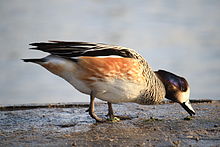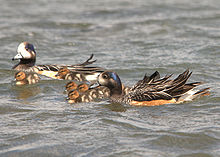- Chiloe Wigeon
-
Chiloe Wigeon 
Male (rear) and female (front) Conservation status Scientific classification Kingdom: Animalia Phylum: Chordata Class: Aves Order: Anseriformes Family: Anatidae Subfamily: Anatinae Genus: Anas Subgenus: Mareca Species: A. sibilatrix Binomial name Anas sibilatrix
Poeppig, 1829The Chiloe Wigeon (Anas sibilatrix) is one of three species of wigeon in the dabbling duck genus Anas. Unlike other wigeons, the sexes are similar (though the male is often slightly brighter) and pairs are monogamous. This bird has a metallic green head, and a gray bill with a black tip. Its breast is barred black and white and its sides are orange brown. It has white cheeks and a white forehead and also white on its wings. Its length is approximately 50 cm.[2]
The female lays between 6 and 10 eggs. This duck is unusual in the sense that the male helps to raise the young.[citation needed]
This duck is found in southern South America, on freshwater lakes, marshes, lagoons and slow flowing rivers. It breeds on the Falkland Islands, Argentina, Uruguay, and Chile. It migrates to southeastern Brazil for the winters.[3] It is an omnivore.
The conservation status of this wigeon is Least Concern.[1]
Contents
Appearance
The Chiloe Wigeon has a body length of 43–54 cm and a wingspan of 75–86 cm.[4] The wing length is about 25 cm and the weight approximately 800 g. Males are usually somewhat larger and heavier.[5] Otherwise sexual dimorphism is relatively subtle.
The Chiloe Wigeon has a black neck and back of the head. The forehead and the front face are white. The black sides of the head gleam greenish, somewhat more strongly pronounced with males. The flanks of males are rust red colored, and light-brown on females. The back plumage is gray with white pulled through. The chest is white with a black transverse waving. Due to the variability in width of the plumage coloring, however, no clear sexing can be made on the basis of the plumage.
The bill is bluish gray with a black bill point. The legs and feet are gray and the eyes are dark-brown. Young birds resemble adult birds, but the red-brown coloring on the flanks is either completely missing or is smaller than the adults.
Range
The Chiloe Wigeon is resident to South America. The northern border of the breeding range is in Argentina at 36° S and Chile at 40° S. It also breeds sparingly in the Falkland Islands.[6] Stray members may also occasionally reach South Georgia, South Orkney and South Shetland Islands.
The Chiloe Wigeon displays a variety of behaviors depending on habitat. Prototypical ducks find themselves flying from the southernmost point of South America to as far north as Brazil during winter.
The IUCN estimates the present population to be around 500,000 adult individuals and determines their numbers are stable in the very large occupancy zone.[7]
Life
The Chiloe Wigeon lives in river valleys, in small artificial lakes and in shallow lagoons of the Pampas. It lives predominantly on vegetables.[clarification needed] It also eats aquatic plants and grass, and occasionally coastal algae.[5]
The Chiloe Wigeon breeds between September and December, in the southern hemisphere spring. Pairs always inhabit very small breeding territories and put their nests in grasses and under bushes. The female lays eight to ten white or light-creme eggs. After a gestation period of approximately 24 to 25 days the ducklings are born. The father helps raise the ducklings, however, he leaves the family once they molt and grow new feathers.
The Chiloe Wigeon was first domesticated in 1870 and 1871 and sent from South America to Europe; it soon bred in zoos. Today it is very widespread due to the attractive plumage coloring.
Further reading
- Hartmut Kolbe; The Ducks of the World, Ulmer Verlag 1999, ISBN 3-8001-7442-1
- Hadoram Shirihai: A Complete Guide to Antarctic Wildlife - The Birds and Marine Mammals of the Antarctic Continent and Southern Ocean, Alula Press, Degerby 2002, ISBN 951-98947-0-5
- Robin and Anne Woods: Atlas of Breeding Birds of the Falkland Islands, Anthony Nelson, Shorpshire 1997, ISBN 0904614-60-3
External links
- "Anas sibilatrix". IUCN Red List of Threatened Species. Version 2010.4. International Union for Conservation of Nature. 2009. http://www.iucnredlist.org/apps/redlist/details/141500.
- Anas sibilatrix videos, photos & sounds on the Internet Bird Collection
Footnotes
- ^ a b IUCN (2009)
- ^ Heinzel, Hermann; Richard Fitter, John Parslow (1977). The Birds of Britain and Europe, with North Africa and the Middle East. (3rd ed.). London: Collins. ISBN 0002192101.
- ^ Clements, J. (2007)
- ^ Ogilvie, Malcolm; Young, Steve (1999). Photographic Handbook of the Wildfowl of the World. Frenchs Forest, N.S.W.: New Holland. ISBN 9781853686252.
- ^ a b Shirihai, P. 247
- ^ Wood, P. 86
- ^ BirdLife Factsheet for Chiloe Widgeon, created on November 26, 2010
References
- Clements, James, (2007) The Clements Checklist of the Birds of the World, Cornell University Press, Ithaca
- IUCN (2009) BirdLife International Anas sibilatrix Downloaded on 8 January 2009
- Sea World
Categories:- IUCN Red List least concern species
- Anas
- Wigeons
- Birds of South America
- Birds of Chile
Wikimedia Foundation. 2010.





